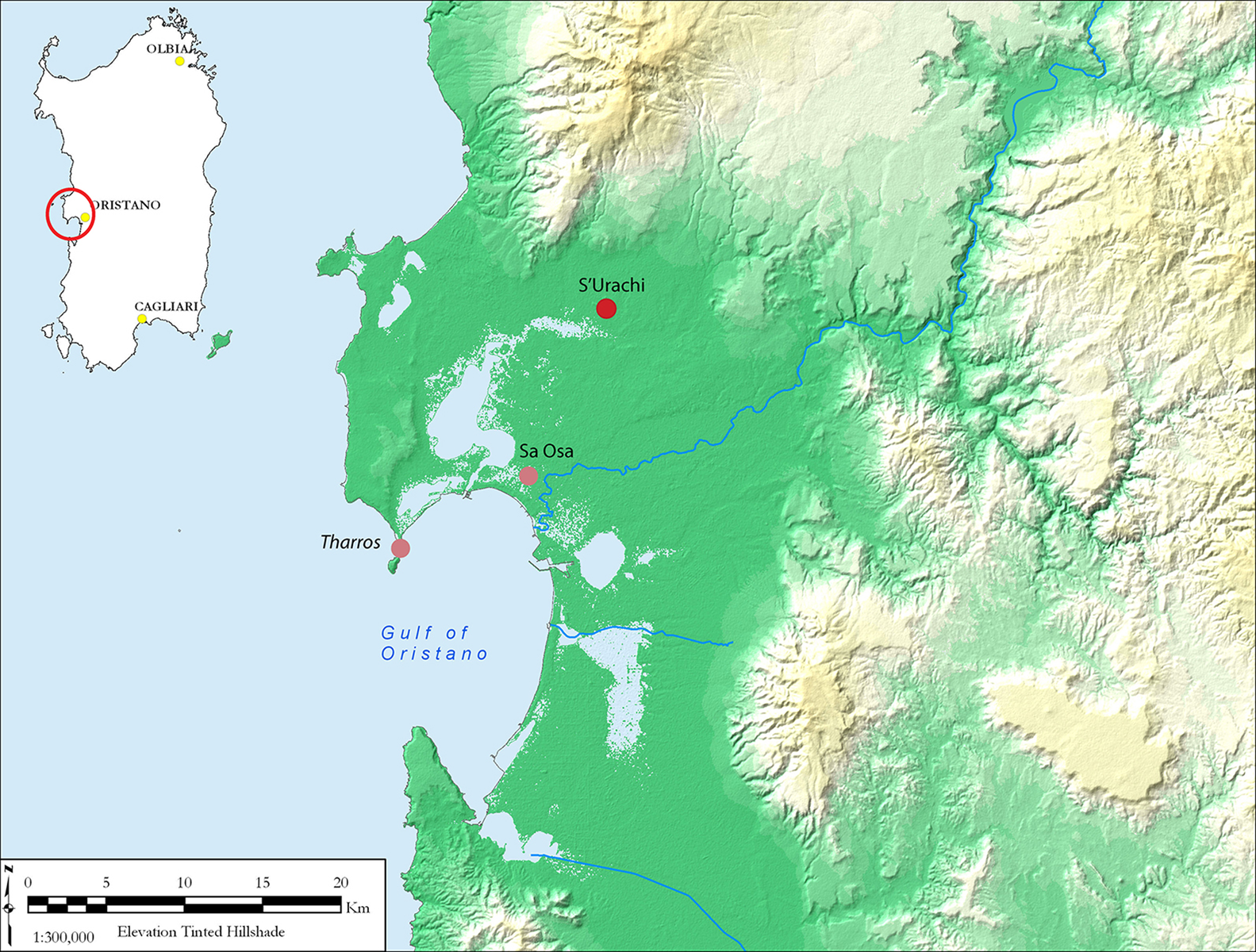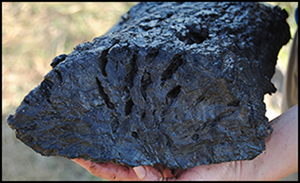Introduction
Nuraghe S'Urachi, a monumental stone structure dating to the Bronze Age, is situated in west-central Sardinia on the northern shores of the Gulf of Oristano, where it dominates the wetlands and plains between the Cabras lagoon and the Montiferru Mountains (Figure 1). This region saw intensive settlement and land use during prehistory, and is densely populated with other nuraghi. In the eighth century BC, Phoenicians established the ‘colonial’ settlement of Tharros on the western shores of the Gulf of Oristano.

Figure 1. Overview map of west-central Sardinia, showing the sites discussed (map by J. Nowlin).
Since 2013, the site of S'Urachi has been the focus of new excavations and a site survey undertaken by Brown University and the Museo Civico of San Vero Milis with the aim of investigating processes of colonial and cultural interaction throughout the first millennium BC, from an indigenous Sardinian perspective (for a discussion of earlier fieldwork, see Stiglitz et al. Reference Stiglitz, Cusí, Ramis, Roppa and van Dommelen2015). By examining how ‘colonial’ outsiders participated in and interacted with the local community at S'Urachi, which had been established sometime around the mid second millennium BC, the project aims to understand the transformation of the social and economic structures of this community in the context of increased Mediterranean connectivity and Phoenician, Carthaginian, and Roman colonialism (Stiglitz et al. Reference Stiglitz, Cusí, Ramis, Roppa and van Dommelen2015).
Given the importance of agriculture and animal husbandry as economic activities for this community, bioarchaeological investigations have consistently been at the forefront of the S'Urachi project (van Dommelen et al. Reference van Dommelen, Cusí, Gosner, Hayne, Pérez-Jordà, Ramis, Roppa and Stiglitz2018), because the increasing connectivity and ever-intensive interactions of the first millennium BC went hand-in-hand with the transfer of skills, techniques and material culture (Roppa et al. Reference Roppa, Hayne and Madrigali2013). With specific regard to agriculture, the adoption of new plant species or the modification of tools and techniques for crop processing, transport and storage are therefore aspects of central concern to the project overall.
In this brief contribution, we report on a rich assemblage of botanical remains of Phoenician date (seventh to sixth centuries BC) recovered from a large dump outside nuraghe S'Urachi, which offers a remarkable opportunity for archaeobotanical research.
Archaeobotanical fieldwork
While S'Urachi is best known for the monumental nuraghe, defined by a massive megalithic wall that still stands four metres tall, the archaeobotanical investigations have focused on the five-metre-wide ditch that has been brought to light in front of the eastern section of the outer wall (Figure 2). While it is unclear whether the ditch surrounded the entire nuraghe, the excavated embankments were evidently constructed in association with the outer wall. The ditch was gradually backfilled from the mid seventh century BC onwards with large amounts of pottery, faunal remains, wood and other botanical material. Due to the nature of the finds and the presence of cut-marks on a modest percentage of the bones of domesticated animals, we regard this assemblage as a largely domestic rubbish dump (van Dommelen et al. Reference van Dommelen, Cusí, Gosner, Hayne, Pérez-Jordà, Ramis, Roppa and Stiglitz2018: 145–46).

Figure 2. Site plan of area E indicating the ditch, and a cross-section (highlighted by the red line) showing a tower of the defensive wall and the ditch in front of it (drawing by E. Díes Cusí).
In order to collect bioarchaeological remains, all contexts of the ditch fill have been systematically and extensively sampled, which has yielded a rich collection of botanical evidence. As S'Urachi is situated at a very low-lying location, and the local water table is unusually high, the lower levels of the ditch were waterlogged; we suspect that the ditch may in fact represent the canalisation of a natural stream (van Dommelen et al. Reference van Dommelen, Cusí, Gosner, Hayne, Pérez-Jordà, Ramis, Roppa and Stiglitz2018: 146–47; Figure 3). The unusual waterlogged conditions have yielded a remarkably well-preserved and diverse assemblage of charred and uncarbonised botanical remains that comprises both seeds and fruits, as well as a range of wood fragments. The associated pottery shows that these finds date from between the mid seventh and mid sixth centuries BC.

Figure 3. Photographs of the ditch, the archaeological excavations and the sampling work (photographs by the S'Urachi Project).
The preservation of waterlogged botanical fragments is unusual in the Mediterranean, especially in settlement contexts. We accordingly adapted our sampling method to include 21 ‘wet samples’ with a collective volume of 130 litres. In the laboratory, these wet sediment samples have been washed with the help of a column of sieves from which all the preserved plant remains were immediately recovered using a binocular magnifying glass and placed back into water for preservation.
Archaeological implications
The archaeobotanical remains recovered from the ditch are both diverse and plentiful. The wood fragments mostly represent waste, but also include several pieces of worked wood. In addition, a trunk of the genus Quercus with a diameter of 0.2m has been recovered, which had been used to support the eastern embankment of the ditch (Figure 4). It has been sampled for dendrochronological analysis.

Figure 4. Photographs of the tree trunk in situ and after removal (photographs by the S'Urachi Project).
The remains of seeds and fruits mostly represent cultivated plants (Figure 5). Particularly abundant are the caryopsis of naked wheat (Triticum aestivum-durum), broad beans (Vicia faba), flax (Linum usitatissimum) and melon (Cucumis melo). Also plentiful are fruits such as grapes (Vitis vinifera), figs (Ficus carica), pomegranate (Punica granatum) and olive (Olea europea). Remains of wild plants include mastic (Pistacia lentiscus) and sloe (Prunus spinosa). Cereals, legumes and oil plants have long (pre)histories of cultivation in Sardinia, while melons, vines, olives and figs have been found on the island since the last third of the second millennium BC (Sabato et al. Reference Sabato, Masi, Pepe, Ucchesu, Peña-Chocarro, Usai, Giachi, Capreti and Bacchetta2015). The evidence from S'Urachi confirms the continuity or reintroduction of these fruit trees, along with new ones such as the pomegranate.

Figure 5. Seeds and fruits: 1) naked wheat (Triticum aestivum-durum); 2) broad bean (Vicia faba); 3) grape (Vitis vinifera); 4) pomegranate (Punica granatum); 5) olive (Olea europaea); 6) fig (Ficus carica); 7) melon (Cucumis melo); 8) sloe (Prunus spinosa); 9) mastic (Pistacia lentiscus). Scale bar = 1mm (photographs by G. Pérez-Jordà).
The pottery associated with the botanical remains is nearly exclusively of Phoenician shapes and types. It is almost entirely locally produced in west-central Sardinia, but draws on both Nuragic and Phoenician manufacturing traditions, which points to complex and intensive artisanal and cultural interactions (cf. Roppa et al. Reference Roppa, Hayne and Madrigali2013). The association between the pottery and the botanical evidence thus suggests that the richly varied botanical assemblage may similarly represent exchanges of skills and crops between Iron Age Sardinians and Phoenicians.
The botanical remains from the ditch at S'Urachi not only make it possible to investigate agricultural production and consumption within this Iron Age community, but they also open up a new window on the early stages of economic and cultural interactions between the local Sardinian communities of west-central Sardinia and the wider Phoenician and Mediterranean world. The waterlogged botanical remains from S'Urachi specifically contribute substantial new evidence to current investigations of the changing nature of agricultural practices and the rural productive economy in the colonial situations that developed around the West Mediterranean in the earlier centuries of the first millennium BC (Pérez-Jordà et al. Reference Pérez-Jordà, Peña-Chocarro, García Fernández and Vera2017). As a corollary, they also add to long-standing debates about cultural interactions between Greek and Phoenician colonisers and indigenous Iron Age inhabitants of the West Mediterranean, including Sardinia.
Acknowledgements
The excavations at S'Urachi are jointly sponsored and funded by the Joukowsky Institute for Archaeology and the Ancient World at Brown University and the Museo Civico of San Vero Milis (Oristano, Sardinia), and co-directed by Alfonso Stiglitz and Peter van Dommelen. Additional financial support for the fieldwork discussed has been provided by the Loeb Classical Library Foundation at Harvard University. The laboratory work has been carried out as part of a project funded by the Spanish Ministry of Science, Innovation and Universities (HAR 2016-76100).








